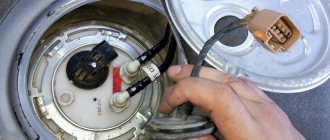The operation of an internal engine is impossible without lubricants. The oil must continuously wash all friction points and rotation points in the mechanisms.
To maintain the functionality of the lubrication system, the engine housing is made in the form of a bath in which a certain volume of technical fluid is constantly located. Using a pump and a complex oil pipeline system, it is supplied to all operating points.
During operation, the lubricant loses its characteristics, so it needs to be renewed periodically. This is a simple operation and can be done independently in a garage. Let's look at the procedure for changing the oil on the popular Volkswagen Polo sedan.
Articles
| Name | Articles |
| Volkswagen Polo until 2015 | |
| Oil filter | 03C115561H |
| Motor oil | VAG G052167M4 |
| Oil drain bolt | N90813202 |
| Volkswagen Polo after 2015 (restyling) | |
| Filter | 04E115561H |
| Oil | VAG G052167M4 |
| Threaded plug | N90288901 |
| Drain plug gasket | N0138157 |
Changing the engine oil
Tools used
To do this job you will need to use the following tools:
- Filter wrench or flathead screwdriver.
- Star key.
- The key is 18.
- Container for draining.
- Dry rags.
- New engine crankcase drain plug.
Step-by-step instruction
It is best to carry out work on changing the oil in the Polo sedan engine on an overpass or in a garage pit:
- You need to warm up the engine, which will ensure appropriate fluidity of the fluid, which will quickly drain from the crankcase of the unit. The car warms up and is driven onto the overpass, after which you should place a container with a capacity of at least 4 liters under the drain hole in the crankcase.
- Open the hood and unscrew the filler cap, into which fresh oil will subsequently be poured.
- After this, you need to crawl under the car, arm yourself with a star key and unscrew the screws that secure the pan cover.
- Next, use an 18mm wrench to carefully unscrew the drain plug. Remember that the oil may be hot, so you need to act as carefully as possible.
- We wait until the old oil drains completely from the engine. This usually takes about 30 minutes. After this, close the drain hole with a new plug.
- Next we replace the oil filter. You can unscrew the old oil filter either using a special wrench or with a flat screwdriver, which is used to pierce the body of the filter element and then use it as a lever.
- It is necessary to pour about a third of fresh oil into the new filter, and also apply this lubricant to the sealing rubber. After this, screw the filter onto the thread and check the tightness of the connection.
- Fill in about three liters of new oil, and its level should reach the middle mark of the dipstick. It is recommended to wait about 5 minutes after adding fresh oil and then check its level.
- Next, start the engine, inspect it for leaks, and let it run for about 5 minutes. We turn off the engine, wait for the engine to cool, and check its level again. If necessary, you will need to remove 400-600 grams of auto-lubricant, after which all service work is completely completed.
Many service center specialists and owners of this car recommend additionally flushing the engine with appropriate auto chemicals when changing the oil. To flush the engine, you will need about three liters of appropriate fluid.
It is poured in immediately after draining the old auto lubricant, after which the engine is started and allowed to run for about 20 minutes. After washing the engine in this way, it is necessary to drain the flushing liquid through the lower plug, and begin replacing the filter and pouring new lubricant into the engine.
Preparatory work
The preparatory process includes the purchase of all consumables. Below are all the consumables needed for the job.
To receive the waste, prepare an empty 5-liter container (canister). Tools you will need:
- Key to remove the filter.
- Socket wrench No. 18.
- Bat "T-25".
- Head No. 13.
- And a ratchet for removing the crankcase protection.
You should also stock up on enough rags and prepare a funnel.
Replacement frequency, what oil to fill
According to the manufacturer's regulations, service changes of engine oil for the Volkswagen Polo Sedan are carried out after 15,000 kilometers or at intervals of 1 year. But some car owners consider this interval to be a little too high, recommending that it be shortened taking into account operating conditions.
The original oil that the manufacturer recommends is Volkswagen Special Plus 5w-40, also known as VAG Special G 5w-40. Available in 1 liter G 052 167 M2 and 5 liter G 052 167 M4.
Oil for Volkswagen Polo Sedan
In addition, it is also recommended to use Castrol lubricant, as evidenced by the inscription on the engine oil filler neck. The Castrol EDGE 5W-30 A3/B4 marking has all the necessary approvals. The inscription Professional and the VW sign may also be present.
Sometimes Polo car owners have a misunderstanding about what viscosity should be chosen: 5w30 or 5w40. The fact is that the manufacturer gives a recommendation when choosing to focus on the VW 502.00 tolerance. And the viscosity is selected based on the climatic zone of use of the machine. By the way, it can be 0W30. But most often, dealers in central Russia fill in 5W-40.
The manufacturer also allows the use of analogues that meet the approval of the VAG concern: VW 502.00. The following brands are most popular among car owners:
- Castrol Magnatec 5W-40 A3/B4
- Liqui Moly Synthoil High Tech 5W-40
- Mobil 1 FS X1 5W-40
- Motul 8100 X-cess 5W40
- RAVENOL VollSynth Turbo VST 5W-40
- Shell Helix Ultra 5W-40
- Total Quartz 9000 5W-40
- Valvoline Synpower 5W-40
- ZIC X9 5W-40
- Lukoil Genesis Armortech 5W-40
From this list, anyone can choose based on preference, price or love for the brand.
How much oil is in the engine lubrication system, volume table
| Model | Engine capacity | Motor marking | How many liters of oil are in the system | Original oil / factory filled |
| Volkswagen Polo sedan | gasoline 1.6 | CFNA | 3.6 | Volkswagen Special Plus 5w-40 |
| CFNB | ||||
| CFW | ||||
| CLSA | ||||
| C.W.V.A. | ||||
| gasoline 1.4 | CZCA |
Oil change for Polo sedan
Changing the oil begins with warming up the power plant. Having opened the garage, to carry out the next maintenance, you need to start the engine.
Do not use jacks during work. Is it dangerous. There is no guarantee that the vehicle will be positioned correctly horizontally. In addition, it is not possible to reach the service area.
- First, remove the filler cap. The hole must be covered with a clean rag to prevent dirt and debris from getting inside the Volkswagen Polo working unit.
- Using Torx “T-25” and head No. 13, we dismantle the protection, if provided class=”aligncenter” width=”750″ height=”484″[/img]
- Using previously prepared clean rags, you must carefully clean the drain plug and the surface around it from dirt.
- We install a container above the crankcase to receive used oil.
- Using a number 18 wrench, you need to slightly loosen the oil drain plug. Goal: unscrew it with your own hands to receive it in a plastic waste container.
- After making sure that the pressure has almost disappeared, you need to update the oil filter. Usually it is unscrewed using a chain puller, as shown in the figure.
- Visually control the oil leakage. If it no longer drains, you need to tighten the plug.
- Fill in new engine oil to ¾ of the total volume recommended by the manufacturer. Use a dipstick to check the oil level in the engine. Add it to the middle of the mark.
- Drive 5 kilometers. Turn off the engine. Let it drain to the bottom of the crankcase.
- At the end of the work, we check the level of the filled engine oil. Don’t forget to inspect the vehicle to ensure there are no leaks in the service area.
Remember to periodically check the engine oil level.
2276-4-8-03
Apply a thin layer of engine oil to the O-ring of the new filter.
We wrap the oil filter by hand and tighten it with a puller to a torque of 20 Nm.
Remove the oil filler cap. From the bottom of the car, clean the oil pan around the drain plug. We place a wide container for draining used oil, with a volume of at least 4 liters, under the drain plug.
When to change engine oil
The manufacturer recommends changing the engine oil at least once a year or 15,000 km , whichever occurs sooner.
After a mileage of 100 thousand km, the oil change period is reduced by 20% every 50,000 km.
From the factory, the engine is filled with original high-quality all-season motor oil Special Plus SAE 5W40. Therefore, during the first change, the oil poured must comply with the specifications specified in the registration certificate of your car.
What oil is used for Volkswagen Polo
The German automobile concern has a huge number of different engines. The same power plants are used on different models, the Volkswagen Polo sedan is no exception. There is an extended list of motor oil specifications that apply to Volkswagen AG vehicles.
| VW 500.00 | VW 501.01 | VW 502.00 | VW 503.00 | VW 503.01 | VW 504.00 | VW 505.00 | VW 505.01 | VW 506.00 | VW 506.01 | VW 507.00 | |
| Soot deposition | + | + | + | + | + | ++ | + | ++ | + | + | ++ |
| Wear | ++ | ++ | + | +++ | ++ | +++ | + | ++ | +++ | +++ | +++ |
| Sludge deposits | + | + | ++ | ++ | ++ | +++ | ++ | ++ | ++ | ++ | +++ |
| Piston deposits | + | + | ++ | +++ | +++ | +++ | + | ++ | +++ | +++ | +++ |
| Oxidative stability | + | + | +++ | +++ | +++ | +++ | — | ++ | ++ | ++ | +++ |
| Fuel economy | — | — | — | ++ | ++ | ++ | — | — | ++ | ++ | ++ |
| Compatible with aftertreatment systems | — | — | — | — | — | ++ | — | — | — | — | ++ |
| Typical viscosity | Any | Any | 0w 30/40 5w 30/40 10w 30/40 | 0w 30 | 0w 30/40 5w 30/40 | 5w 30 | Any | 5w 30/40 | 0w 30 | 0w 30 | 5w 30 |
In this case, the compliance of the tolerance for a particular motor is determined by the instructions for routine maintenance. For Polo sedan this is VW 502 00. According to the manufacturer’s descriptions, the lubricant is suitable for gasoline engines with a fuel injection system.
The tolerance allows lubricant to be poured into power plants with increased boost, and, accordingly, liter capacity. The European certification for this approval is ACEA A3.
This basic composition is intended for cars that have a standard (in other words, shortened) replacement interval specified in the service book.
In addition, the automaker has certified the VW 504 00 approval, the so-called “Longlife”. Changing such oil in the Polo sedan is done half as often. Of course, provided that the interval is provided for in the service book.
Information
The same engines are installed on other models of the concern: for example, AUDI, Skoda, Seat. Accordingly, Volkswagen approvals also apply to them.
So what kind of oil should you put in the engine? The manufacturer recommends (without directive instructions, otherwise antitrust laws will be violated) the so-called VW branded oil.
While you are being discussed at the dealer service (and you will have to do this, at least during the warranty period), rest assured that this particular consumable will be filled in for you. Then you can choose the brand yourself.
Required volume of lubricant
In addition to the fact that the motorist must know what kind of oil is required for the power unit of his car, he should also take into account the volume of motor fluid required for operation. In order to find out the number of liters required, you can read the operating instructions. As practice shows, engine performance will be optimal only when in a Volkswagen Polo Sedan with an engine capacity of 1.6 liters. 3.6 liters will arrive. lubricants If exactly the specified amount of motor lubricant enters the power unit, it will be possible to track its level using a dipstick, which will take the average value between the permissible limits (“min” and “max”).
As a rule, the motor lubricant that is poured into the Volkswagen Polo is sold in cans of different sizes; the buyer can purchase oil with a volume of 1, 4 or 5 liters. If the car has considerable mileage, you should take into account the fact that the engine consumes lubricating fluid. That is why manufacturers recommend giving preference to purchasing oil in four- and five-liter containers, which will allow you to replenish the missing liquid if necessary.
Signs and consequences of “aging” motor oil
There are no visual signs indicating the need to replace the lubricant. Many car enthusiasts, especially beginners, mistakenly believe that since the oil composition has darkened, it needs to be changed. In fact, this only speaks in favor of the lubricant product. If the liquid has darkened, it means it cleans the engine well, adsorbing slag deposits. But those oils that do not change their color over time should be treated with caution.
The only guideline that provides information about replacement is the mileage since the last lubricant update. Despite the fact that official dealers offer replacement after 10 or 15 thousand km, this should be done more often, without driving more than 8 thousand. After all, Russian gasoline contains many impurities that oxidize the oil and cause the loss of its protective properties. We should also not forget that in difficult urban conditions (traffic jams) the engine runs for a long time while the machine is idle - that is, the lubricant life is still reduced. With each lubricant change, the oil filter must also be changed.
What happens if you change the oil at extended intervals?
If you do not take the frequency of replacement seriously, or if you fill in a lubricant that is not suitable for the engine, this can lead to a decrease in engine life. This diagnosis does not appear immediately, so it is invisible. The oil filter becomes clogged and the engine begins to be washed with dirty engine fluid containing slag, sludge and small chips.
The consequences of untimely oil changes will be catastrophic for the engine.
Contaminants settle in oil lines and on the surfaces of parts. Engine oil pressure drops and eventually disappears completely. If you do not pay attention to the pressure sensor, the following will follow: jamming of the pistons, rotation of the connecting rod bearings and breakage of the connecting rods, failure of the turbocharger and other damage. In this condition, it is easier to buy a new power unit, since major repairs will no longer help it.
If the engine timing belt is in this condition, you should immediately remove, clean and wash the oil pan
If the situation is not yet hopeless, active flushing and then periodic replacement with high-quality fresh oil after 1–1.5 thousand km of quiet driving at low engine speeds can help. This replacement procedure must be performed 2-3 times. Perhaps then the major repairs will be delayed for some time.











